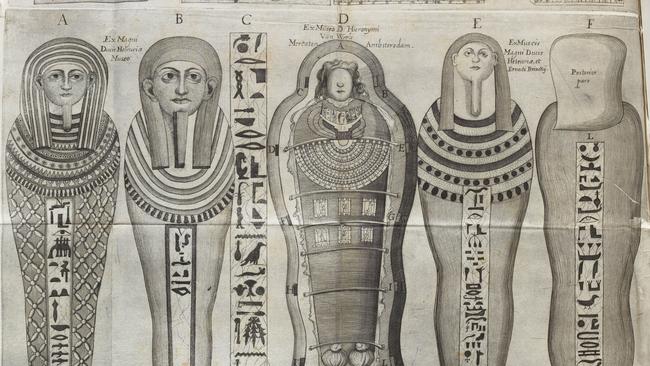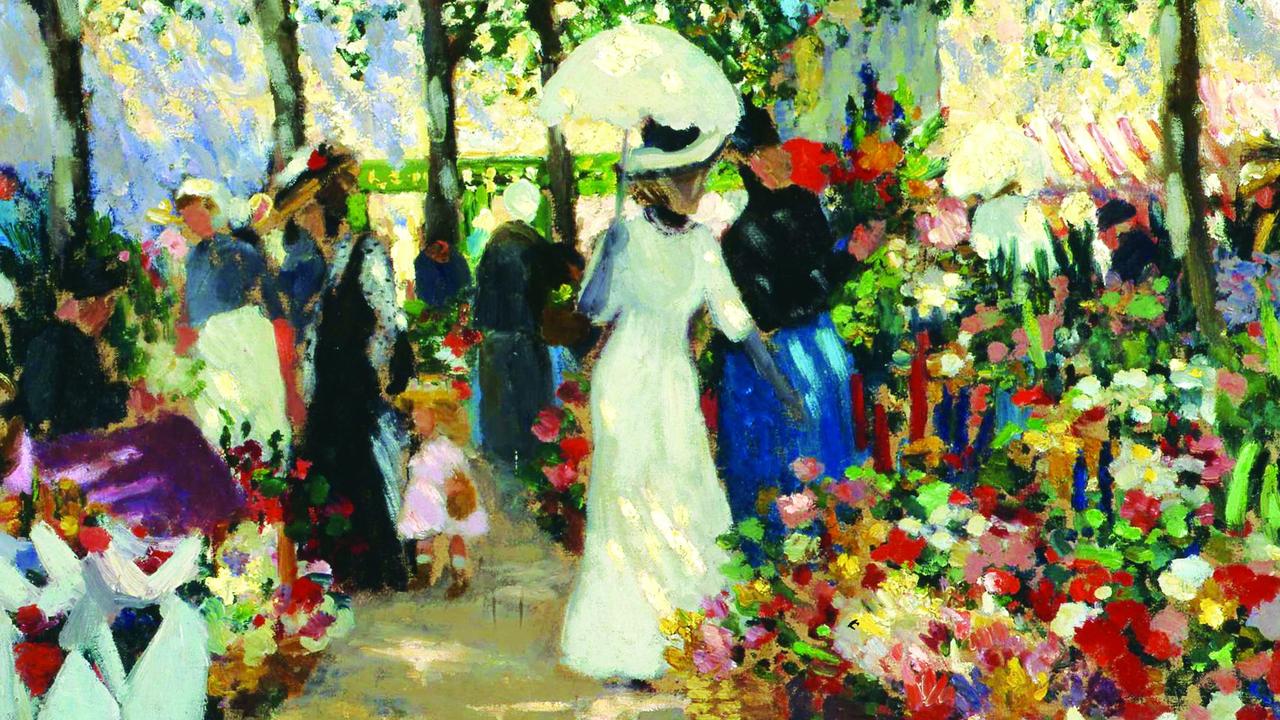Why Dante and co still matter: Christopher Allen review
A new exhibition traces the history of book design, production and illustration

No one has read all the books in their library. There are volumes that are well-thumbed and worn from being carried around in satchels or coat pockets, and others that are brand new, barely opened, intended for future reading or simply to be available for reference. There are whole shelves that represent past interests, reading programs or research projects, and others that are the promise of topics to be broached or subjects to be learned one day.
Great libraries are even more unfathomable; it is almost impossible to conceive of the range of subjects and periods they cover, from the most arcane to the most banal. A large public library will hold everything from precious incunabula and manuscripts to government gazettes, the reports of local councils, official manuals and regulations issued by ministries and statutory authorities.
Books and other documents may also be in any number of languages, which cannot even be catalogued if they cannot be read. No doubt the staff of a large public library would include people familiar with the more common European languages – French, Italian, German or Spanish – but unless it has extensive holdings of Oriental material it probably doesn’t have specialists capable of reading Arabic, Persian, Hindi, Chinese or Japanese.
Such libraries are inexhaustible continents of knowledge, whose resources and even extent will always exceed the range and efforts of their custodians, but which are constantly being explored and mapped, gradually adding to the sum of our knowledge. And some of the discoveries made are regularly presented to the public in changing displays and exhibitions, such as the State Library of Victoria’s World of the Book, now open in a new version after Covid lockdown.
It is well worth exploring the State Library building on the way in to the exhibition. Directly above the entrance is the original reading room, the Queen’s Hall (1861), which has recently been restored. On the way up to this room visitors can admire Septimus Power’s war memorial mural, the subject of a book I reviewed here some weeks ago; facing it is the slightly later allegory of peace by Napier Waller.
Returning to the ground floor, you walk through a vast reception area which is actually the basement of the main reading room; at the end of this room you climb a few steps to reach a gallery space hung with a number of fine paintings, including William Strutt’s famous Black Thursday (1864). From here you proceed straight ahead to another reading room or turn back and climb a few more steps the beautiful octagonal La Trobe reading room, built in 1913, with rows of desks radiating from the centre like the spokes of a wheel.
A lift takes you to the top floor, where the exhibition is displayed. It begins with a cuneiform tablet, reminding us of the invention of writing about 5000 years ago, but also that the first written texts were strictly utilitarian, in this case a record of tax paid in goats; such was the humble beginning of a revolution in human thinking.
One of the broader themes that arises from this exhibition is the role of private collectors and benefactors in helping to form great public collections. One of these was John Emmerson (1938-2014), who studied nuclear physics at Oxford before turning to law; while there, he fell in love with early books and eventually assembled an exceptional collection especially of the Tudor and Stuart periods. The 5000 items he left to the Library extend from literary and historical volumes to pamphlets like an account of the execution of Charles I, printed and circulated the day after his death.
This is now an invaluable resource for historical and literary research, but it is unlikely that it could have been put together by a public library today, especially in Australia, with parochial pressures to collect material narrowly relevant to the nation or even to a state within the Commonwealth; and when the increasing preoccupation with so-called “diversity”, as well as a preference for ideology over history, make it hard to focus on quality and substance.
The story of Dr David Hailperin (1814-60) is also a fascinating one. He was born in Romania, and after a time working there as a rabbi, studied medicine in Turkey, presumably in Constantinople, before moving to England and thence emigrating to Australia. He practised medicine in Melbourne and Bendigo, but also claimed to be a clairvoyant, collecting Hebrew texts and books related to Jewish mysticism. Shortly before his death he was forced to pawn his library, which was subsequently purchased and then sold to the Library.
Hailperin was particularly interested in the mystical tradition of the Kabbalah, whose foundational text, as a label explains, was the Zohar, meaning “splendour”, written in the 13th century by a Spanish Jewish author, Moses de Leon; though as so often in esoteric literature, the book is attributed to a legendary mystic who had lived over a thousand years earlier.
One book in the collection is a reinterpretation of the Zohar by a 16th-17th century rabbi from Fez in Morocco who later migrated to Palestine. Another 17th century author was born in Germany but studied Kabbalah in Poland, while a third, who was influenced by the Enlightenment and rejected the Kabbalah, was born in Poland, studied in Germany and Italy and finally ended up as court physician to the Sultan in Constantinople.
All of these cases, like that of Hailperin himself, remind us that Jewish culture, co-existing with both Christians and Moslems, extending from the Sephardic Jews of North Africa and Spain to the Ashkenazi of Central Europe, maintained a living connection to the Orient. Meanwhile many of the Sephardic Jews of Spain had migrated, after the expulsion of 1492, to the more tolerant environments of England or Holland.
The Kabbalistic tradition fascinated syncretistic Neo-Platonic thinkers in Renaissance Italy and as late as the 17th century. One of the most interesting individuals in this tradition was the Jesuit polymath Athanasius Kircher, who also believed that he had deciphered the Egyptian hieroglyphs.
The Jesuits were in the forefront of linguistic studies because of their missionary activities throughout Asia, and because they believed in learning the languages of the local people so that they could preach directly and without relying on translators. They also adopted local dress and many local customs. Not surprisingly, they were much more successful than rival orders, who complained to Rome that the Jesuits were going native.
As a result of their innovative approach to missionary work, the Jesuits became the authors of our first grammars and dictionaries of most Asian languages; under these circumstances, Kircher’s ambition to decipher the hieroglyphs was a reasonable one, even if the real answer was not found until the time of Champollion.
Kircher also draws on the new linguistic knowledge, albeit in a characteristically eccentric way, in an extraordinary Kabbalistic diagram that seeks to demonstrate that the Hebrew name for God written in four letters, the Tetragrammaton – not to be spoken by the pious – is matched by four-letter words for the name of God in every other known language, even if he has to spell the English name as “Good”.
A particular focus of the current exhibition is Dante, in recognition of the 700th anniversary of the great poet’s death in 2021 – when this exhibition would have opened if not for Covid lockdowns. Unlike Virgil, who died with the Aeneid still incomplete and unrevised, Dante was fortunate enough to complete the Divine Comedy in 1320, the year before his death.
His poem had an unparalleled influence on the development of the Italian language (he developed, for example, a vastly more extensive vocabulary than any previous author in the language), and he has thus always been venerated in Italy.
It was different elsewhere in Europe, where the poet’s vision of Hell, Heaven and Purgatory held little appeal for readers in the age of the Scientific Revolution and especially the Enlightenment. But that changed dramatically with the Romantic period, which rediscovered the Middle Ages, reinterpreted religious experience, and was fascinated both by the sublime in nature and by the many layers of affective, imaginative, oneiric and non-rational human experience. Since the first complete English translation in 1802 and the first complete verse translation in 1814, Dante has been avidly read and repeatedly translated into English and other European languages; by a strange quirk of history, this great author who belonged to the cusp of Medieval and Renaissance periods, after being ignored during the Early Modern centuries, became an essential reference for Modernism.
Surprisingly, or perhaps not considering the prevailing culture in our public galleries, no exhibition was mounted in Australia to commemorate this anniversary, even though it would have been quite easy to assemble paintings and sculptures (Rodin’s in particular) inspired by Dante’s work. So it fell to the State Libraries in Sydney and Melbourne to pay modest tributes to the author of whom T.S. Eliot wrote: “Dante and Shakespeare divide the world between them. There is no third.”
Dante’s importance in Italy was so great that the first printed edition, or editio princeps, appeared in 1472, less than 20 years after Gutenberg’s Bible. This was followed, notably, by the 1481 Florence edition with commentary by Cristoforo Landino and some illustrations based on drawings by Botticelli. The first fully illustrated edition came out in Venice 10 years later, and from then illustrations appeared regularly.
It is no doubt because Dante’s evocations of the world of the afterlife are so vivid that artists have been impelled to turn them into concrete images. Here we can see, for example, the scene from Inferno I in which Dante speaks of his encounter with the three threatening allegorical beasts in Filippo Giunti’s 1506 edition, or another of his meeting with Beatrice at the beginning of Paradiso, in a 1529 reprint of the Landino edition. Botticelli’s original drawings for that edition have been lost, but another set rediscovered in the 19th century is represented here by a 1921 Nonesuch Press edition.
The illustrations in early printed books – and indeed in all books before the development of photogravure about a century and a half ago – are woodblock prints, because a woodblock can be printed in the same press and with the same pressure as letterpress; engravings and etchings, which are intaglio prints, require much greater pressure.
More recent illustrations to Dante reflect his modern rediscovery, from John Flaxman (1807) to William Blake who produced a great suite of watercolours – many now held in the NGV – in the 1820s, or Gustave Doré’s dense woodblock illustrations from the 1860s. Many others in the 20th century – and perhaps none more prominently than Tom Phillips, whose remarkable edition of the Inferno (1979-83) was only acquired by the Library in 2021 – attest to the enduring power and resonance of Dante’s moral vision.



